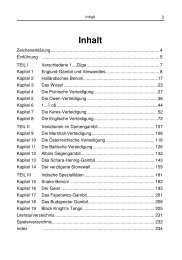Knight on the Left - Schachverlag Kania
Knight on the Left - Schachverlag Kania
Knight on the Left - Schachverlag Kania
You also want an ePaper? Increase the reach of your titles
YUMPU automatically turns print PDFs into web optimized ePapers that Google loves.
The Van Geet Attack 1. c3 d5 2.e4 d4 3. ce2 51<br />
As we have seen, Black’s equalizing measure<br />
is ...exf4, plus afterwards taking e5 under<br />
c<strong>on</strong>trol. He should not allow <strong>the</strong> advance<br />
f4-f5. Regarding this, I would like to outline<br />
some differences to <strong>the</strong> King’s Indian:<br />
White doesn’t take <strong>on</strong> f5 because after<br />
e4xf5 g6xf5! (White is missing <strong>the</strong> analogous<br />
move in <strong>the</strong> Van Geet Attack) he<br />
cannot keep <strong>the</strong> g7-bishop under c<strong>on</strong>trol<br />
in <strong>the</strong> l<strong>on</strong>g run - ...e5-e4 is in <strong>the</strong> air. On<br />
<strong>the</strong> o<strong>the</strong>r hand, Black doesn’t play ...f5xe4<br />
(after xe4 White has a nice square <strong>on</strong><br />
e4) but ...f5-f4. The kingside attack with<br />
...g5-g4 etc is str<strong>on</strong>g but not superior to<br />
White’s queenside attack with c4-c5 as<br />
<strong>the</strong> g7-bishop is <strong>on</strong>ly obstructing its own<br />
pieces <strong>on</strong> <strong>the</strong> g-file. With a bishop <strong>on</strong> c5<br />
- this would corresp<strong>on</strong>d to <strong>the</strong> Van Geet<br />
Attack, with colours reversed - <strong>the</strong> attack<br />
would be much more vigorous:<br />
Mazzoleni – Briozzo<br />
Villa Ballester 1993<br />
18... b8<br />
Gritting his teeth, he allows f4-f5.<br />
After 18...exf4 19. xf4 (19. gf5!?) Black<br />
is not yet ready to fight for <strong>the</strong> vital c<strong>on</strong>trol<br />
over e5, e.g. 19... g4 20.e5 b8<br />
21. gf5 xf5 22. xg4 . The resource<br />
... g6 (e.g. after taking <strong>on</strong> f4 twice) is not<br />
available due to <strong>the</strong> pin of <strong>the</strong> b3-bishop.<br />
19... xf4 20. xf4 g5!? looks faulty, but<br />
it isn’t easy to refute: 21. xf6! xf6 22.<br />
h5 e5 (22... b6 23.e5 or 22... h8<br />
23. c7, with very good compensati<strong>on</strong>)<br />
23. f3! g4 (23... h8 24.e5) 24. xe5<br />
xe2 25. g3 (<strong>the</strong> point, <strong>the</strong> bishop is trapped)<br />
25... xd3 26. xd3 ac8 27. f1 with<br />
an advantageous endgame for White.<br />
c<strong>on</strong>cerning <strong>the</strong> fork ...g7-g5 after f2-f4,<br />
compare Game 21, note g2 to Black’s 6th<br />
move, including <strong>the</strong> insert which follows it.<br />
19.f5 h8 20. h5 xh5?<br />
More stubborn was 20... eg8, after which<br />
White c<strong>on</strong>tinues his attack with 21. xf6<br />
xf6 22.g4. Black lacks counter-play but<br />
retains some chances for defence.<br />
21. xh5 g8<br />
21...f6 22. xh6.<br />
22.f6! g6 23. xg6+ fxg6 24. xg6<br />
xf6 25. xf6 d8 26. f7 1-0<br />
A possible disadvantage of f2-f4 had already<br />
been menti<strong>on</strong>ed: The weakening<br />
of <strong>the</strong> e3-square. In <strong>the</strong> following example<br />
this weakness turns out to be illusory:<br />
Casper – Möbius<br />
East Germany (ch) Plauen 1980



